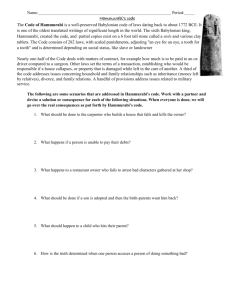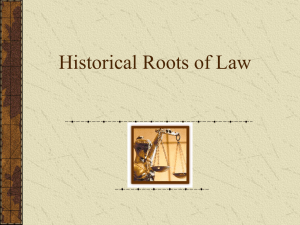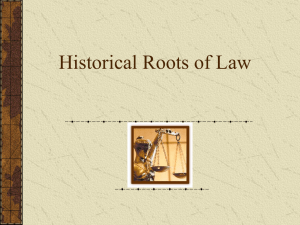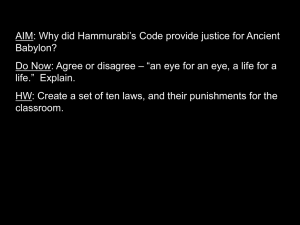Comparison and Contrast Between the Legal Codes of
advertisement
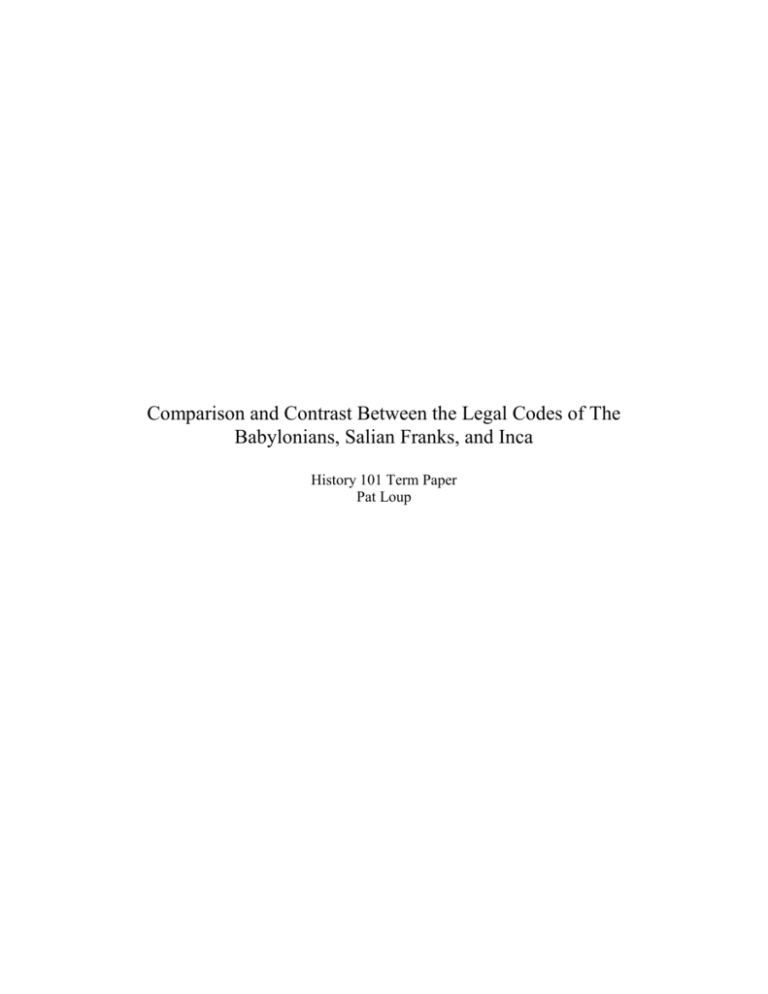
Comparison and Contrast Between the Legal Codes of The Babylonians, Salian Franks, and Inca History 101 Term Paper Pat Loup All civilizations have some form of judicial or moral code. Some of these are lenient and some are harsher (it is however worth noting that these are subjective terms.) Laws also tend to evolve over time, some faster and some slower than others. Three interesting cases of legal codes in history involve such codes of the Salian Franks, the Babylonians under Hammurabi, and the Inca. The Babylonians were an early Middle Eastern people who, in this instance, lived under Hammurabi and his code of laws in the mid 18th century BCE. The Salian Franks were the founders of a new Germanic dynasty in post-Roman Europe. The Inca were South American natives who had their own prolific empire on the western part of the continent spreading from Colombia and as far south as present-day central Argentina. Each of these groups of people from very different time periods and points on earth had differing legal codes. In some cases however, the legal codes were similar. Hammurabi’s Code was written in the mid 18th century BCE by Hammurabi himself1. At the time, Babylon was a violent place pervaded by a religion that had no firm ethical structure, no “Treat others as you wish to be treated.” It was because of this that Hammurabi felt that a code involving what became known as Lex Talionis, or “Law of Retaliation” should be the basis of his legal code. The Code of Hammurabi included 1 Hammurabi, Hammurabi’s Code, ed. USM History Department, Envisioning World Civilizations: A Primary Source Workbook, second edition (Mason, OH: Cengage, 2010), 34 rulings including things such as “If a life has been lost, the city or district governor shall pay one mina of silver to the deceased’s family,” “If a priestess, who is not living in the convent, open a beer-shop, or enter a beer-shop for a drink, that woman shall be put to death.”2 It is easy to see that while what equated to state-funded life insurance existed in such an archaic time period, it was also a time of harsh rulings that made priestesses able to be put to death if they were found entering or attempting to open a bar. Further examples of the polar ends of Hammurabi’s code include laws providing that people who came to put out house fires would be cast into the flames if they took things from the building3, as well as repayment of dowry upon divorce4. It is worth noting that the Code of Hammurabi includes varying degrees of punishment for the differing class systems and who was affected by crimes. While the punishments vary with the class systems, the majority are still very eye-for-eye in nature. The code of the Salian Franks was first issued in the early 5th century of the Common Era. It was seen in the cited rendition under King Clovis I; however it probably originated from a much earlier time. The code of the Salian Franks shows more organization and concern for clearly outlined areas of the law than the Hammurabi’s Code. Some of its sections clearly state how laws are to be applied to certain members of 2 Hammurabi, Hammurabi’s Code, ed. USM History Department, Envisioning World Civilizations: A Primary Source Workbook, second edition (Mason, OH: Cengage, 2010), 34 3 Hammurabi, Hammurabi’s Code, ed. USM History Department, Envisioning World Civilizations: A Primary Source Workbook, second edition (Mason, OH: Cengage, 2010), 34 4 Hammurabi, Hammurabi’s Code, ed. USM History Department, Envisioning World Civilizations: A Primary Source Workbook, second edition (Mason, OH: Cengage, 2010), 35 society5 (Romans, Franks, slaves, as well as tribes of other barbarians resided in the kingdom.) The code of the Salian Franks is not as “black and white” as Hammurabi’s Code. It is a more updated code including things such as court summonses6, a more detailed procedure regarding arson7, and the difference between theft by a freeman and a slave8. It also regards more civil ideas such as debt repayment and inheritance laws9. Corporal punishment was also less common in the code. Payment of varying degrees according to the crime and social status of the defendant were used much more frequently. Even slaves were to pay fines if they were found guilty of theft of something worth more than 40 denarii. As times changed (some 1200 years in this case), so did rulers and legal codes. While both legal codes provide rulings on similar things, the Code of the Salian Franks was more focused on simple repayment for crimes and of making sure that justice was done without bringing further violence upon the civilization. As seen 5 Clovis, The Code of The Salian Franks, ed. USM History Department, Envisioning World Civilizations: A Primary Source Workbook, second edition (Mason, OH: Cengage 2010), 44 6 Clovis, The Code of The Salian Franks, ed. USM History Department, Envisioning World Civilizations: A Primary Source Workbook, second edition (Mason, OH: Cengage 2010), 45 7 Clovis, The Code of The Salian Franks, ed. USM History Department, Envisioning World Civilizations: A Primary Source Workbook, second edition (Mason, OH: Cengage 2010), 44 8 Clovis, The Code of The Salian Franks, ed. USM History Department, Envisioning World Civilizations: A Primary Source Workbook, second edition (Mason, OH: Cengage 2010), 45 9 Clovis, The Code of The Salian Franks, ed. USM History Department, Envisioning World Civilizations: A Primary Source Workbook, second edition (Mason, OH: Cengage 2010), 46 in the examples given for the Code of Hammurabi, that civilization was more focused on swift, “equal” physical punishment. The Incan legal code was, in this instance, recorded by a Spanish missionary by the name of Bernabè Cobo. In his taking down of the Incan code, he noted that the Inca had no system of writing and that the legal code was instead remembered and passed down from the Incan king through tradition10. As he states that the laws he chose to record are only the laws which most Inca remember, it would appear that some laws may have been forgotten over time or simply fell out of use. The Incan law combines both the tit for tat punishment system used by the Babylonians as well as a more inquisitive process used by the Salian Franks. Whereas in most cases of Babylonian law, punishment was swift and corporal regardless of crime or caste, the Inca made attempts to find fault and prove guilt. In some cases the Incan law allowed for pardons in one such example that stated if a traveler stole fruit from land that belonged to a common farmer out of necessity, he was issued a pardon, whereas if he stole fruit from the Inca, he was put to death11. There was also space provided for repeat offenders and varying degrees of crime. While the details of the laws in these civilizations show the way in which justice was served in varying time and place, they also stood as a representation of how the civilizations felt about the need for justice. These laws all represent a cultural and historical representation of what different people feel law’s purpose was. The 10 Cobo, Bernabe, History of the Inca Empire, ed. USM History Department, Envisioning World Civilizations: A Primary Source Workbook, scond edition (Mason, OH: Cengage, 2010), 47 11 Cobo, Bernabe, History of the Inca Empire, ed. USM History Department, Envisioning World Civilizations: A Primary Source Workbook, scond edition (Mason, OH: Cengage, 2010), 48 Babylonians for example felt that law was a requirement but that there was simply right and wrong and that punishments for wrong should vary from class to class. The Babylonian leaders were swift to carry out their idea of justice (which almost always involved physical punishment) whenever a misdeed was reported. While there were varying degrees with which people were punished according to the crime committed, Babylonian law stood as a system for dealing out punishment, not for upholding equality or fairness. The Inca had a similar law system, following on the use of punishment, exile, and execution much like the Babylonians, however they also factored in things such as fault and circumstance. Whereas in the Babylonian way, thieves would have to pay a fine or have their hands hewn off in the event that they steal something, things such as how poor the thief was, if thievery was deemed necessary, and who was stolen from. Incan law was more concerned with finding reasonable punishment to fit the crime as opposed to having set right-wrong principles that matched up with retributive punishments. The Salian Franks had a legal system that approached that of modern legal systems. It was not there to dole out harsh punishments but to maintain order and instill justice; a way to insure that the good stay good and that the wrongdoers are punished. The code of the Franks balanced punishment that was hard on people in the form of monetary fines both light and heavy while also refraining from mutilating people due to minor infractions.
